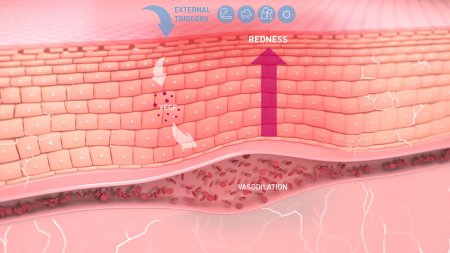Red skin is considered an inflammatory disorder. Skin overreacts to specific triggers that it considers a threat. When exposed to these triggers, blood vessels dilate, epidermal nerve endings are stimulated and we feel hot and uncomfortable. This is flushing.
Our skin also relies on the vascular endothelial growth factor, or VEGF. This is necessary for growing new blood vessels to irrigate the skin. However, when it is overexpressed, blood vessels dilate and dermal fibres are weakened. Redness becomes permanent (erythrosis). Some blood vessels may become visible (telangiectasis), and stay that way.
While we therefore have some idea of the processes involved in temporary or permanent skin redness, we don’t actually fully understand what causes them. If we can’t get rid of redness on the face, the best strategy is therefore to manage the symptoms.











